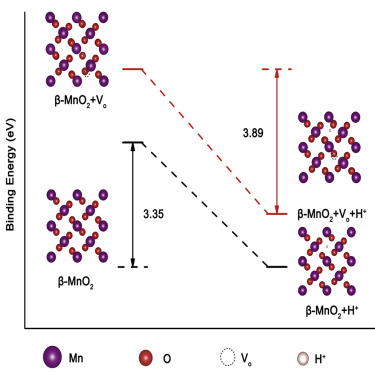iScience ( IF 5.8 ) Pub Date : 2019-12-26 , DOI: 10.1016/j.isci.2019.100797 Mingming Han 1 , Jiwu Huang 1 , Shuquan Liang 2 , Lutong Shan 1 , Xuesong Xie 1 , Zhenyu Yi 1 , Yiren Wang 1 , Shan Guo 1 , Jiang Zhou 2

|
Rechargeable aqueous Zn/manganese dioxide (Zn/MnO2) batteries are attractive energy storage technology owing to their merits of low cost, high safety, and environmental friendliness. However, the β-MnO2 cathode is still plagued by the sluggish ion insertion kinetics due to the relatively narrow tunneled pathway. Furthermore, the energy storage mechanism is under debate as well. Here, β-MnO2 cathode with enhanced ion insertion kinetics is introduced by the efficient oxygen defect engineering strategy. Density functional theory computations show that the β-MnO2 host structure is more likely for H+ insertion rather than Zn2+, and the introduction of oxygen defects will facilitate the insertion of H+ into β-MnO2. This theoretical conjecture is confirmed by the capacity of 302 mA h g−1 and capacity retention of 94% after 300 cycles in the assembled aqueous Zn/β-MnO2 cell. These results highlight the potentials of defect engineering as a strategy of improving the electrochemical performance of β-MnO2 in aqueous rechargeable batteries.
中文翻译:

β-MnO2中的氧缺陷,可实现高性能可充电锌/二氧化锰水溶液。
可再充电的Zn /二氧化锰水溶液(Zn / MnO 2)由于具有低成本,高安全性和环境友好的优点而成为有吸引力的储能技术。然而,由于相对较窄的隧穿路径,β- MnO 2阴极仍然受到缓慢的离子插入动力学的困扰。此外,储能机制也正在辩论中。在此,通过有效的氧缺陷工程策略引入了具有增强的离子插入动力学的β- MnO 2阴极。密度泛函理论计算表明,β- MnO 2主体结构更可能用于H +插入而不是Zn2 +,氧缺陷的引入将促进H +插入β- MnO 2中。该理论推测由302毫安汞的能力证实-1和在组装的水溶液的Zn / 300次循环之后的94%的容量保持率β -MnO 2细胞。这些结果突出了缺陷工程的潜力,作为改善水性可充电电池中β- MnO 2电化学性能的策略。


























 京公网安备 11010802027423号
京公网安备 11010802027423号